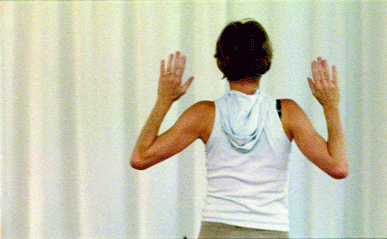Claire Denis surprisingly disengaged from her documentary about Mathilde Monnier
It’s fitting that Claire Denis’ latest film, a documentary on choreographer Mathilde Monnier, turns to the subject of dance. The most memorable scene in her filmography also involves this art––Denis Lavant’s spastically joyful movements to Corona’s “Rhythm of the Night” at the end of “Beau Travail.” By conventional standards, Lavant is a terrible dancer (at least in this scene), but Denis doesn’t mock him. His performance is a true release––the first in a film about masculinity’s repressions––and cathartic both for the character and audience.
If dance liberated Lavant, what might a whole film devoted to it do for Denis?
The results, alas, are pretty disappointing. Denis made several documentaries early in her career, but one might hope that she’s returning to the form because it allows possibilities alien to narrative cinema. However, she’s pushed the boundaries of storytelling pretty far, especially in “Beau Travail” and “The Intruder.” She’s never given the impression of being shackled to narrative; rather, she’s always taken it on her own terms. “The Intruder,” which played last month at the Walter Reade, is a thriller with all its connective tissue missing, turned into an impressionistic series of events and images. Her most difficult film, it demands to be seen several times or not at all.
In fact, “Towards Mathilde” shows a far less adventurous approach to narrative and character than “The Intruder.” The “plot” is simple––Monnier tries to create several new pieces. She finds the process frustrating, at times feeling that her dancers aren’t progressing beyond her initial demands. In the end, she succeeds, leading to a performance that becomes the film’s finale and highlight.
“Towards Mathilde” is a backstage musical of sorts. It never discusses the private lives of Monnier and her dancers but airs all the tribulations of choreography. It’s one of very few recent documentaries made on film, rather than digital video. Working with both Agnes Godard, her usual cinematographer, and Hélene Louvart, Denis shot “Towards Mathilde” on Super-8 and 16mm. The early Super-8 scenes revel in fuzzy, grainy textures, but the 16mm footage looks slicker, if not exactly glossy. To add to the grubbiness, the camera’s motor is sometimes audible.
A friend suggested to me that Denis has the sensibility of a gay man, a notion I don’t really agree with. Her films express the desires of a heterosexual woman to a degree that few female directors have pursued. She eroticizes the male body in ways that, until now, only gay men have done. Much like Wong Kar-wai’s films, there’s a free-floating eroticism to her work, whether sexuality is portrayed directly or indirectly. Her sex scenes make it difficult to determine exactly whose body parts we’re seeing.
“Towards Mathilde” is disappointingly prosaic, perhaps because many of the bodies Denis is observing are female, outside her erotic interest. After more than an hour of often tedious rehearsal footage, “Towards Mathilde” finally starts showing long stretches of performance. The ending is a dazzling number performed by a man in an Andy Warhol wig, partially shown in split screen. For the first time in this film, she fully uses the expressive potential at her disposal––stylized lighting, bright colors, deep shadows, a vivid score. In earlier rehearsal scenes, PJ Harvey’s music made less of an impact.
A thrilling way to close “Towards Mathilde,” it suggests that Denis was running on empty the rest of the time. The most talented French director of the generation that emerged in the ‘80s, she seems to be taking it easy and letting reality take its course in this film, even as she pushes the realm of fiction in increasingly daring directions.
gaycitynews.com



































